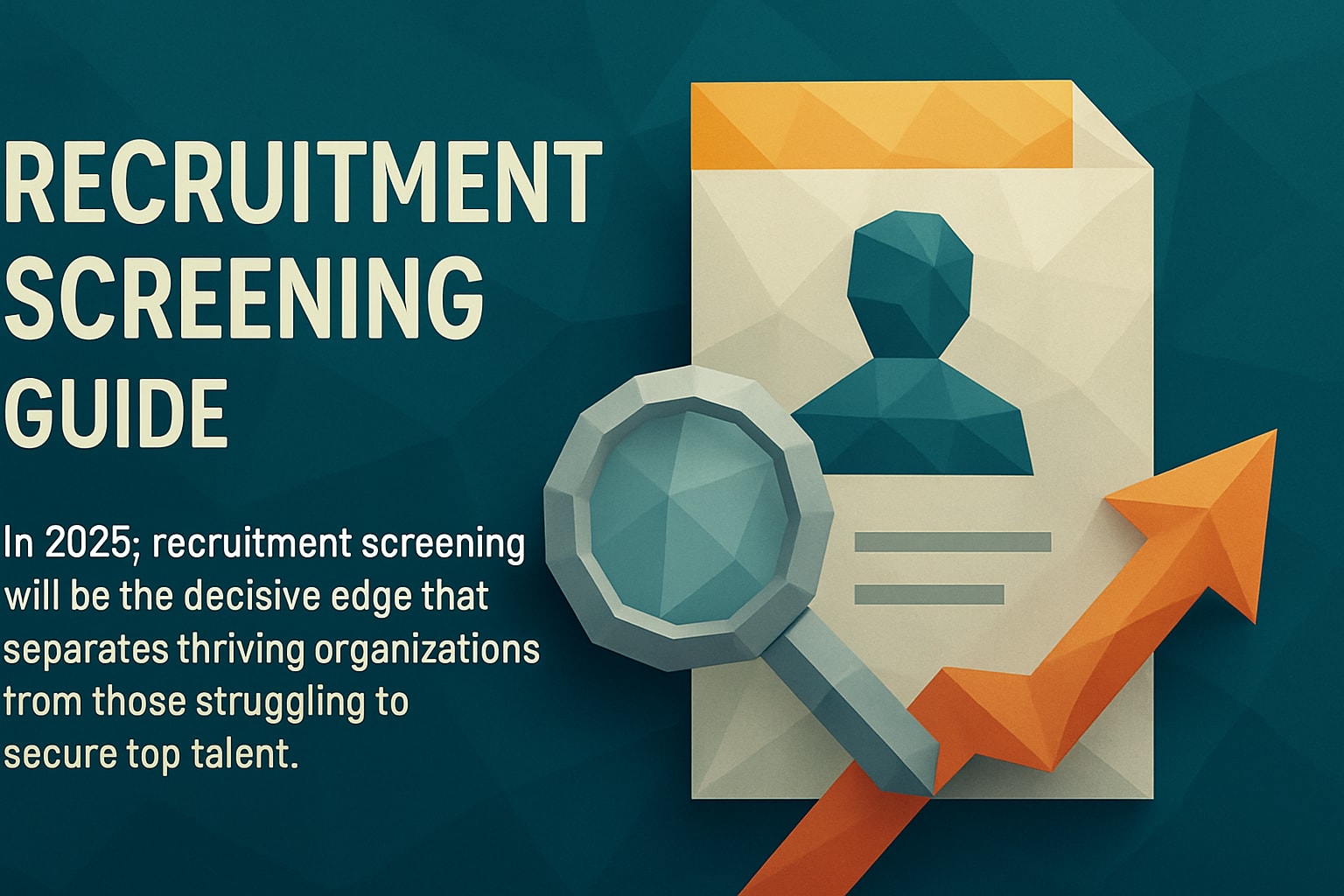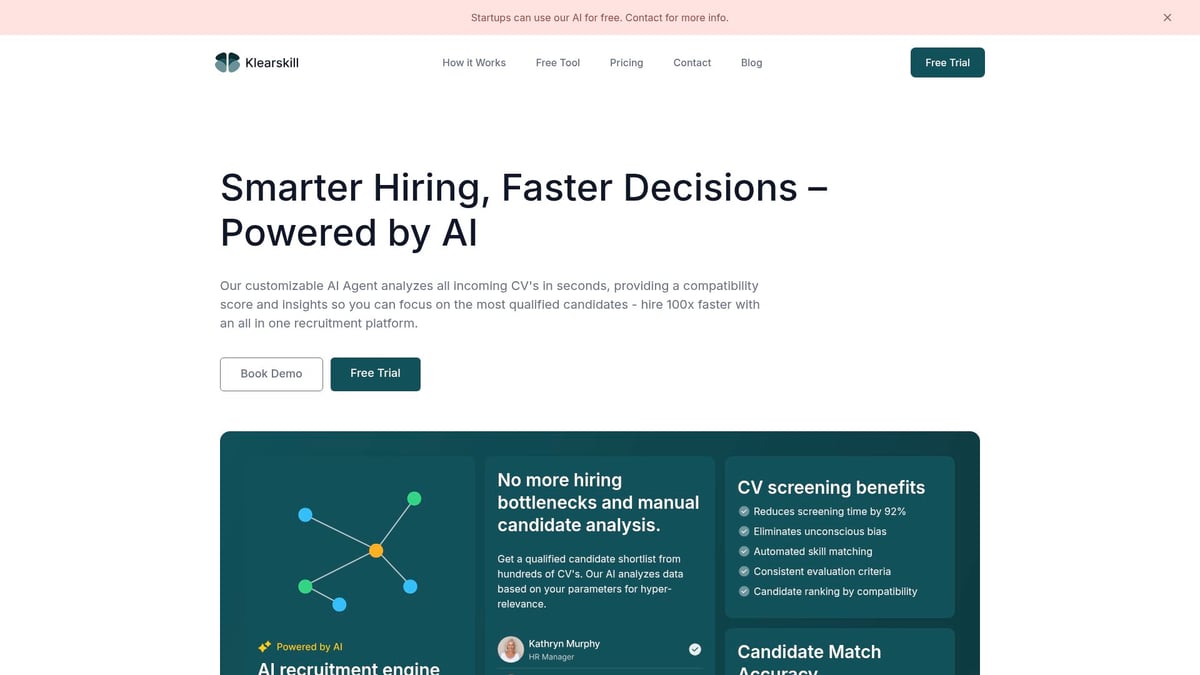October 5, 2025
Recruitment Screening Guide: Strategies for Success in 2025

In 2025, recruitment screening will be the decisive edge that separates thriving organizations from those struggling to secure top talent. This comprehensive guide equips recruiters and HR professionals with the latest strategies, technologies, and best practices to transform recruitment screening into a streamlined, fair, and high-quality process. Discover how to navigate evolving trends, optimize every step of your screening workflow, leverage cutting-edge technology including AI, ensure compliance, and deliver an outstanding candidate experience. Get ready to future-proof your hiring approach and drive better results with practical, actionable insights.
The Evolving Landscape of Recruitment Screening in 2025
Recruitment screening is undergoing a rapid transformation as organizations prepare for 2025. The landscape is shaped by changing workforce dynamics, technological innovation, stricter regulations, and rising candidate expectations. Understanding these shifts is essential for recruiters aiming to stay competitive.

Key Trends Shaping Recruitment Screening
Several pivotal trends are redefining recruitment screening. The rise of remote and hybrid workforces is expanding candidate pools beyond traditional geographic boundaries. As a result, organizations now face a surge in application volumes for each role. The demand for diverse and inclusive hiring is more pronounced, with skills-based hiring taking precedence over formal degree requirements. In fact, over 70 percent of companies now prioritize skills assessments above academic credentials, reflecting a shift toward practical competencies. For a deeper dive into these developments, see Top Recruitment Trends and Statistics for 2025.
The Impact of Technology and AI
Technology is revolutionizing recruitment screening by automating repetitive tasks and enhancing decision-making speed. AI-driven tools can rank and match candidates with remarkable efficiency, using predictive analytics to forecast both fit and retention. For example, companies utilizing AI report a 92 percent faster generation of shortlists compared to manual processes. These advancements allow recruiters to focus more on strategic activities, while technology manages the heavy lifting of initial evaluations.
Data-Driven Decision Making
Data is at the core of modern recruitment screening. Analytics platforms now empower teams to make unbiased, consistent decisions by providing real-time dashboards and detailed recruitment KPIs. This transparency ensures that every stage of the process is measurable and improvable. Notably, 60 percent of HR leaders identify analytics as critical for enhancing hiring quality. By leveraging data, organizations can continuously refine their approach and achieve superior hiring outcomes.
Regulatory and Compliance Considerations
Compliance is increasingly complex in recruitment screening due to evolving data privacy laws such as GDPR and CCPA. Organizations must navigate these regulations to ensure fairness, transparency, and secure handling of candidate data. Many companies updated their screening processes in 2024 to align with new standards, focusing on consent-based practices and ethical use of AI. This proactive stance helps mitigate legal risks and builds trust with candidates.
Candidate Expectations and Experience
Candidates today expect a seamless, transparent recruitment screening journey. They value timely communication and mobile-friendly application tools. Long or opaque processes often lead to high drop-off rates, with 78 percent of candidates abandoning lengthy screenings. To attract top talent, organizations must optimize every touchpoint, from application to feedback, ensuring that candidates feel informed and respected throughout their experience.
Step-by-Step Recruitment Screening Process for 2025
A robust recruitment screening process is essential for attracting, evaluating, and hiring the best talent in 2025. Each step, from defining role requirements to completing background checks, shapes your organization’s ability to secure high-quality hires efficiently. Let’s explore a proven, step-by-step approach to recruitment screening that balances speed, fairness, and accuracy.

Step 1: Defining Job Requirements and Success Criteria
The foundation of effective recruitment screening begins with clear, collaborative job definition. Work closely with hiring managers to identify must-have and nice-to-have skills, as well as relevant experience and cultural fit.
Use data from your top-performing employees to establish benchmarks for success. Skills matrices and competency frameworks offer objective criteria to guide your selection process. This approach not only clarifies expectations but also supports fair and consistent recruitment screening across all roles.
By setting precise requirements, teams reduce bias and focus on candidates most likely to excel. Accurate job profiles ensure that every subsequent screening step aligns with organizational goals and workforce needs.
Step 2: Sourcing and Attracting Qualified Candidates
Once requirements are set, recruitment screening success depends on reaching the right talent pool. Start by optimizing job postings for clarity, inclusivity, and appeal to diverse candidates.
Leverage niche job boards, professional communities, and targeted outreach through platforms like LinkedIn Recruiter. Social sourcing allows you to connect with passive candidates who may not be actively searching but fit your criteria.
A multi-channel sourcing strategy increases the quality and diversity of your candidate pipeline. By casting a wide net and using data-driven outreach, recruitment screening becomes both more efficient and equitable for every role you fill.
Step 3: Application Review and Initial Screening
As applications arrive, structured and automated processes are key to managing volume and maintaining fairness. Implement checklists and pre-screening questions to quickly identify unqualified applicants.
Automated keyword matching tools can help recruiters focus on the most relevant profiles. To further streamline this stage, many organizations now rely on automated resume screening software, which accelerates the review process and ensures consistent evaluation.
By standardizing initial recruitment screening, you minimize unconscious bias and make data-driven decisions, ensuring every candidate receives a fair opportunity.
Step 4: Skills and Assessment Testing
Moving beyond resumes, recruitment screening in 2025 emphasizes skills and assessments tailored to each role. Online platforms enable you to administer cognitive, technical, and behavioral tests efficiently.
For technical positions, use coding challenges or simulations. For management roles, situational judgment tests and personality assessments provide valuable insights. These tools measure real-world ability and potential, not just past experience.
Structured assessments ensure recruitment screening is both objective and predictive, helping you identify candidates who can truly excel in the position and adapt to your organizational culture.
Step 5: Structured Interviews and Evaluation
Interviews remain a central part of recruitment screening, but structure is crucial for fairness and consistency. Develop standardized interview questions and scoring rubrics tailored to each role’s requirements.
Train interviewers to use the STAR method (Situation, Task, Action, Result) for behavioral interviews. This approach encourages candidates to provide specific, relevant examples while reducing subjectivity in evaluations.
A well-structured interview process empowers hiring teams to compare candidates easily and make informed decisions, strengthening the overall recruitment screening framework.
Step 6: Reference and Background Checks
The final step in recruitment screening is verifying candidate credentials and backgrounds. Automate reference collection where possible to speed up the process and gather honest feedback from previous employers.
Use digital platforms for background checks that ensure accuracy and compliance with privacy regulations. Always obtain candidate consent before collecting sensitive information.
By integrating secure, efficient reference and background checks, organizations complete their recruitment screening process with confidence, minimizing risk and ensuring a reliable, high-quality hire.
Integrating AI and Automation into Recruitment Screening
Artificial intelligence has rapidly become a cornerstone in recruitment screening, fundamentally changing how organizations identify top talent. By automating complex and repetitive tasks, companies can focus on strategic decision-making and candidate engagement. The adoption of AI is not just a trend but a competitive necessity for modern recruitment teams.
Benefits of AI-Driven Screening
AI-driven recruitment screening delivers tangible benefits to hiring teams. It accelerates the evaluation process, allowing recruiters to sift through thousands of applications in minutes. This speed leads to faster shortlisting and reduces time-to-hire, helping organizations secure high-quality candidates before competitors do.
Another key advantage is the reduction of unconscious bias. AI systems can analyze candidates using standardized criteria, ensuring every applicant is assessed fairly. For technical roles, organizations are seeing up to 97% match accuracy, demonstrating the precision possible with these solutions.
Automation also frees up recruiters to focus on strategic tasks, such as candidate relationships and employer branding. With these efficiencies, recruitment screening becomes more consistent, data-driven, and scalable.
Key Features to Look for in AI Recruitment Tools
Selecting the right AI tools is critical for effective recruitment screening. Look for platforms that offer customizable scoring and ranking algorithms. This allows you to tailor the system to your specific hiring criteria, ensuring alignment with organizational goals.
Integration capabilities are equally important. Your chosen tool should connect seamlessly with your applicant tracking system (ATS) and other HR platforms, enabling real-time data sharing and streamlined workflows. Features like bi-directional data sync keep candidate profiles updated and eliminate manual data entry.
Advanced analytics dashboards are another must-have, providing insights into candidate pipelines, process bottlenecks, and hiring outcomes. For a deeper understanding of how these tools transform recruitment, explore this AI-powered recruitment tools overview.
Addressing Bias and Ensuring Fairness
Ensuring fairness in recruitment screening is essential, especially as AI adoption grows. The best systems are trained on diverse, unbiased datasets, minimizing the risk of replicating historical prejudices. Regular audits of AI algorithms help monitor for any emerging bias, allowing for timely adjustments.
Transparency is also crucial. Clearly communicate to candidates how AI is used in the screening process and offer opportunities for feedback. Some organizations are achieving up to 99% bias reduction by combining robust data practices with ongoing monitoring.
Maintaining fairness builds trust with both candidates and hiring managers, making recruitment screening more inclusive and effective for all stakeholders.
How AI-Powered Solutions Like Klearskill Transform Screening
Klearskill exemplifies the transformative power of AI in recruitment screening. Its advanced algorithms analyze resumes, evaluate skills, and generate ranked shortlists almost instantly. This results in a 92% reduction in screening time, significantly accelerating the hiring cycle.

Klearskill’s platform allows for customizable evaluation criteria, ensuring alignment with specific role requirements. Seamless integration with ATS solutions means recruiters can access up-to-date candidate data without manual effort. With 97% accuracy reported for technical roles, organizations improve both efficiency and quality of hires.
For businesses seeking scalability, fairness, and actionable analytics, Klearskill provides an end-to-end solution that keeps recruitment screening future-ready.
Implementation Best Practices
To maximize the benefits of AI in recruitment screening, start with a pilot program. Select a control group to test the new tool and compare outcomes with your existing process. This approach helps identify strengths and areas for improvement before a full rollout.
Train your recruitment team on interpreting AI-generated insights, emphasizing how to use the data for better decision-making. Regularly evaluate tool performance, gathering feedback from both recruiters and candidates to ensure continuous improvement.
By following these steps, organizations can ensure their recruitment screening strategy remains efficient, fair, and adaptable as technology evolves.
Ensuring Compliance, Ethics, and Data Security in Screening
Maintaining compliance, ethics, and data security is fundamental to a robust recruitment screening process. As regulations and technology evolve, organizations must proactively safeguard candidate rights and organizational integrity.

Navigating Global and Local Regulations
Recruitment screening must align with a rapidly shifting landscape of global and local regulations. Laws like GDPR and CCPA require clear consent for data collection and transparent processing methods. Organizations should regularly review privacy policies and update workflows to reflect new requirements.
It is crucial to stay informed about regional updates and implement consent-based practices. According to recent insights on Top 5 Employment Screening Trends in 2025, 40 percent of organizations revised their recruitment screening policies in 2024 to ensure compliance. This proactive stance not only avoids legal pitfalls but also builds trust with candidates.
Ethical Screening Practices
Ethical recruitment screening centers on transparency, fairness, and respect for candidates. Inform applicants when automated or AI-based screening tools are used. Offer clear explanations of evaluation methods and provide candidates with opportunities to request additional feedback or clarification.
Best practices include:
- Disclosing the use of automated decision-making.
- Offering candidates the right to ask for screening rationales.
- Ensuring assessments align with role requirements.
Upholding these ethical standards in recruitment screening fosters trust, minimizes bias, and enhances an organization's reputation.
Protecting Candidate Data and Privacy
Data security is a non-negotiable element of recruitment screening. Employers must use secure, encrypted platforms to handle applications. Limit access to candidate information to only those directly involved in hiring.
Key security steps:
- Enable multi-factor authentication for all recruiter accounts.
- Regularly audit access logs for unauthorized activity.
- Store sensitive data in compliance with legal requirements.
Protecting candidate data during recruitment screening helps prevent breaches and maintains candidate confidence throughout the process.
Auditing and Continuous Improvement
Continuous improvement is essential for effective recruitment screening. Regularly audit your screening processes to identify gaps in compliance, ethics, and security. Use feedback from candidates and hiring teams to refine workflows and address any recurring issues.
Recommended actions:
- Conduct quarterly compliance audits.
- Update screening criteria in response to legal or market changes.
- Monitor outcomes to ensure fairness and effectiveness.
By embedding ongoing review into recruitment screening, organizations can adapt to evolving standards and consistently deliver high-quality, ethical hiring experiences.
Optimizing Candidate Experience Throughout Screening
In 2025, candidate experience is a critical differentiator in recruitment screening. Every interaction, from application to final feedback, shapes how talent perceives your organization. By focusing on simplicity, transparency, and personalization, you can reduce drop-off and attract top candidates who might otherwise disengage.
Streamlining the Application Process
A streamlined application is the foundation of a positive recruitment screening experience. Candidates expect efficiency and clarity at every step. Start by minimizing required fields and eliminating redundant questions. Offer the ability to upload resumes directly from cloud services, making the process seamless on any device.
Mobile-friendly design is essential. More than ever, job seekers use smartphones to apply, so ensure your recruitment screening platform adapts to all screens. According to recent research, 78 percent of candidates prefer applications that take less than 15 minutes to complete. By simplifying forms and offering clear progress indicators, you set the stage for higher completion rates and better first impressions.
Communicating Transparently and Promptly
Clear, timely communication is central to a world-class recruitment screening process. Set expectations early by outlining timelines and next steps in your initial outreach. Automated status updates keep candidates informed without overwhelming your team, reducing anxiety and uncertainty.
Prompt responses to inquiries demonstrate respect for candidates’ time. Consider integrating chatbots or automated email sequences to deliver information quickly. According to industry data, 65 percent of candidates say that fast, honest communication is the most valued part of their recruitment screening journey. For more strategies on elevating candidate interactions, review how to improve candidate experience.
Reducing Candidate Drop-Off
High drop-off rates can signal friction points in your recruitment screening workflow. Use analytics to monitor where candidates disengage and address bottlenecks as soon as they appear. Streamlining assessments and ensuring instructions are clear can make a significant difference.
Regularly solicit feedback from candidates who exit the process early. Implement quick surveys or follow-up emails to identify common pain points. After simplifying application steps, organizations often see drop-off rates decrease by up to 30 percent. By continually refining the recruitment screening journey, you keep more qualified talent engaged through to the final decision.
Personalizing the Screening Experience
Personalization transforms recruitment screening from a transactional process into a memorable, candidate-centric journey. Tailor assessments to align with each candidate’s background and the specific skills needed for the role. Offer flexible interview scheduling, including options for video or phone formats.
Utilize technology to customize communication, addressing candidates by name and referencing their unique experiences. Chatbots can answer questions in real time, while automated reminders help candidates prepare for each stage. By focusing on personalization throughout recruitment screening, you enhance satisfaction and improve your chances of securing top talent.
Future-Proofing Your Recruitment Screening Strategy
To stay ahead in recruitment screening, organizations must build strategies that are as dynamic as the talent market itself. Future-proofing your process means embracing change, investing in people, and leveraging technology for continuous improvement. Let us explore how you can ensure your recruitment screening strategy remains agile and relevant.
Embracing Continuous Learning and Upskilling
To future-proof recruitment screening, continuous learning is essential. Recruiters must stay updated on emerging tools, legal requirements, and best practices. Many leading companies now invest in annual upskilling programs, ensuring their teams remain proficient in new technologies and screening methodologies.
Encouraging knowledge sharing across hiring teams fosters innovation and consistency. Holding regular workshops or peer-led training sessions helps recruiters adapt quickly to new processes. This focus on growth not only drives efficiency but also strengthens the overall recruitment screening framework.
Leveraging Advanced Analytics for Ongoing Improvement
Advanced analytics is transforming recruitment screening into a data-driven discipline. Tracking long-term hiring outcomes and candidate performance uncovers patterns that drive smarter decisions. By monitoring key performance indicators, organizations can refine their screening criteria, reduce bias, and improve quality of hire.
Recent Recruitment Statistics for 2025 reveal that companies using analytics see measurable gains in hiring speed and retention. Leveraging predictive analytics allows teams to anticipate hiring needs and optimize every stage of the recruitment screening process.
Adapting to Emerging Talent Market Trends
Remaining responsive to market trends is vital for effective recruitment screening. As candidate expectations shift, organizations must adjust their sourcing and screening strategies. The rise of remote work, demand for flexibility, and focus on soft skills all influence how talent is assessed.
Monitoring industry reports and candidate feedback helps recruiters spot changes early. Incorporating remote-ready assessments and valuing adaptability ensures the recruitment screening process attracts and retains top talent in a competitive landscape.
Building an Agile, Scalable Screening Framework
An agile approach to recruitment screening enables organizations to respond quickly to changing hiring volumes and new role requirements. Modular workflows and regular process reviews keep the system flexible. This adaptability is key to managing both high-volume and niche hiring without sacrificing quality.
Leveraging foundational resources, such as What is pre-employment screening, helps teams maintain compliance and consistency as they scale. By updating tools and policies based on feedback, recruiters ensure their recruitment screening process remains robust and future-ready.
